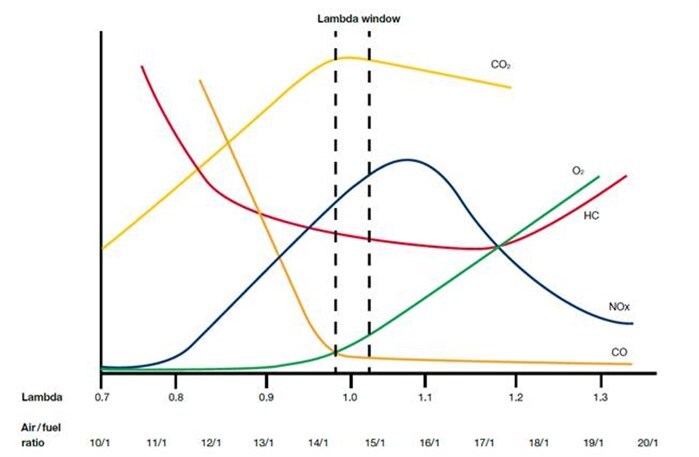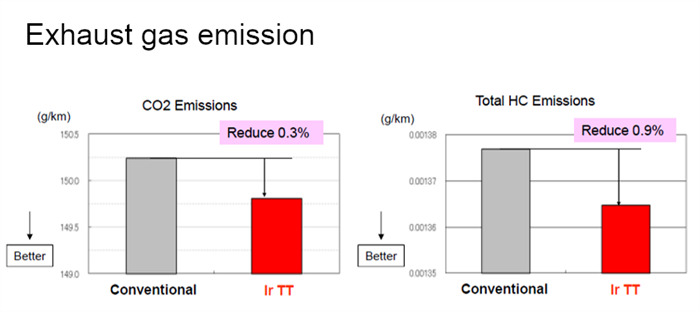How the right spark plug can reduce vehicle emissions

The background: EURO 6 and car emissions
The automotive industry has been working for some time to reduce the emissions of internal combustion engine vehicles, in line with regulations. In the European Union, EURO 1 emissions standards came into effect in 1992, marking the first universal standards for newly registered vehicles. This was an important step, but the EURO 1 requirements – including fitting a catalytic converter and switching to unleaded petrol – now seem quite basic.
Since then, we have made significant progress, and today the sixth generation of standards – EURO 6 – is in effect. These cover several different emitted pollutants, including carbon monoxide, hydrocarbons, nitrogen oxides and particulates – and it’s expected that conforming to EURO 6 will also reduce a car’s CO2 emissions and general running efficiency. (This is important as the EU has also introduced new CO2 emissions targets for new cars: 95g/km, equivalent to 4.1L/100 km for petrol or 3.6L/100 km for diesel cars).
We’ve summarised the main emitted compounds of concern in Table 1 below:
Pollutant | Symbol | Effects | Causes |
Carbon monoxide | CO | Partially burnt fuel that can enter the bloodstream and replace oxygen, which restricts the ability of blood to carry oxygen through the body | Rich mixture, poor ignition (spark or ignition system fault), poor combustion, incorrect ignition timing |
Hydrocarbons | HC | Unburnt fuel is carcinogenic and can affect cell growth in the body. Can react with other pollutants to form ozone | Rich mixture, poor ignition (spark or ignition fault), poor combustion, incorrect ignition timing |
Oxides of nitrogen | NOx | Can cause irritation of eyes and lungs, and create respiratory problems. Contributes to smog and acid rain. Also contributes to ground-level ozone | Produced during high-temperature combustion with lean mixtures, where nitrogen in the air reacts with oxygen |
Carbon dioxide | CO2 | A build-up of CO2 in the atmosphere traps heat and contributes to climate change | Product of complete combustion of fuel and oxygen |
Table 1: Main pollutants, their effects and causes
As you can notice, a large number of car parts and processes can cause or reduce emissions, depending on how they function. Therefore, improving engine design to find new efficiencies, and make improvements to ignition and fuel systems, has become a focus for the industry. This is why, when replacing engine components as part of normal car maintenance, it is recommended to use modern parts that benefit from improved technology as opposed to the original parts that were fitted to the vehicle at the time of manufacture.
The graph in (Figure 1) shows the changing ratios of main pollutants and oxygen in exhaust gas. It illustrates how even small changes in the air/fuel ratio can noticeably increase or decrease the levels of pollutants. When the air/fuel ratio is kept within the lambda window, a reasonable compromise is achieved between the different pollutants. But the graph also shows that our work is not complete; with new developments in engine technology, we should be able to further reduce emissions of some compounds, especially CO2.

Figure 1: How air/fuel ratio affects pollutant levels
How do DENSO spark plugs play a role in reducing emissions?
Spark plugs are one of the key ignition components in petrol, CNG and LPG engines, determining exactly how much fuel gets burned in the combustion cycle. Referring back to Table 1, you’ll see that a correctly timed spark and ‘clean’ combustion is associated with reducing emissions of a number of pollutants. Figure 2 below shows how DENSO Iridium TT achieves a reduction in CO2 and hydrocarbon emissions from the exhaust, when compared to a conventional spark plug in a standard test vehicle.

Figure 2: The extent to which DENSO Iridium TT spark plugs can reduce emissions versus a conventional spark plug
As one of the largest automotive component manufacturers in the world, DENSO’s ambition is to take a central role in making vehicles and components operate efficiently, allowing vehicles to meet current emission standards. As part of this objective, DENSO is constantly innovating to deliver new spark plug technologies, optimizing their durability, reliability and operating range so engines always achieve timely ignition and ensure clean combustion.
To support this, it is crucial to check and maintain the health of spark plugs. Replacing the spark plug more often is the first step; even better is to replace it with a new Denso TT spark plug, ensuring there is new technology inside the engine.
Fewer faults means lower emissions
Spark plugs transfer ignition energy into the combustion chamber and create a spark between the ground and centre electrode, igniting the air/fuel mixture. They operate within a volatile atmosphere with high fluctuating temperatures.
Over time, spark plug electrodes can wear, increasing the ignition voltage required for them to work properly. Eventually they may reach a point at which their ignition voltage demand is not supported by the ignition coil, potentially leading to misfires. Increased misfires are directly correlated to increased emissions, since they produce waste and make the vehicle operate less efficiently.
To minimize spark plug fault risk (and emissions as a result), workshops should stock and fit spark plugs that match OE quality and have newer technology than the OEM part. DENSO also encourages a preventive maintenance routine: periodically diagnosing and, if needed, replacing spark plugs during service intervals, rather than waiting for the warning indicator to turn on. Taking precautions can reduce the risk of misfires or carbon fouling, thereby maintaining peak fuel efficiency and helping the car continue to meet all emissions standards.
DENSO has been a market leader in spark plug manufacture since 1959, and today manufactures a comprehensive range of spark plugs to QS 9000 and ISO 9000 standards, with a ‘zero defect’ guarantee. This outstanding reliability is also available to the aftermarket. Explore the DENSO Spark Plug range now.




















































